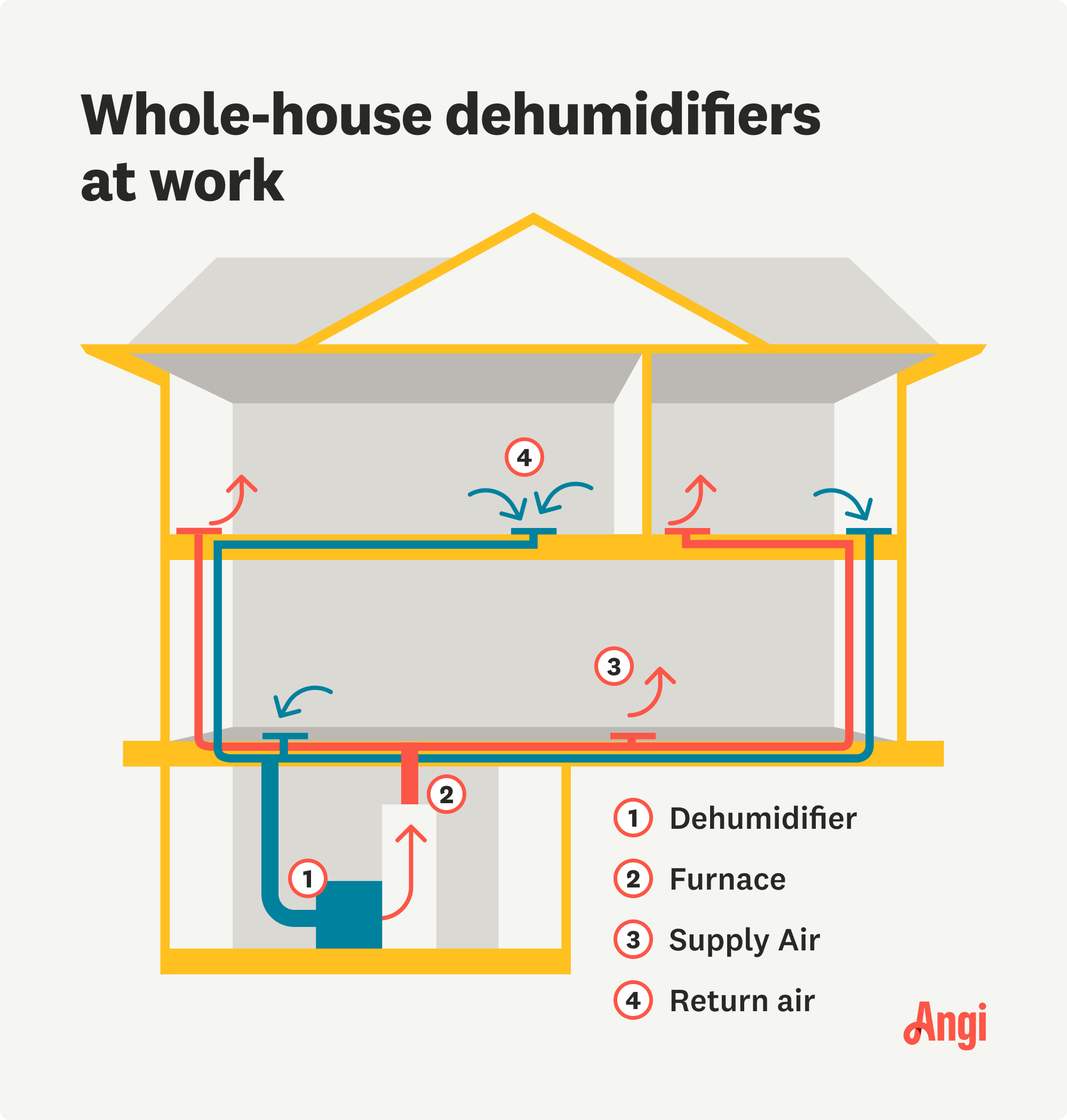
When your heat goes out, it can cause a bit of a panic. But knowledge is power, so let's go over radiator repair costs before that happens.
Don’t sweat the excess humidity in your home—get a dehumidifier


Dehumidifiers reduce the humidity in the air and keep it at a consistent level.
The three types of dehumidifiers are refrigeration, desiccant, and whole-house dehumidifiers.
Hire a licensed HVAC professional to install your whole-home dehumidifier safely and efficiently.
Your home’s humidity is a delicate balance. If you’re wondering what a dehumidifier does, we’ve got you covered.
While you want a decent level of moisture in the air to keep humans, animals, and plants happy, high humidity levels can cause inadequate airflow, poor ventilation, mold growth, warping and possible compromise of your home’s structural integrity, and worsened health conditions, such as allergies and asthma. Fortunately, dehumidifiers can mitigate excess humidity and maintain an ideal, consistent humidity level. This guide will review functions, types of dehumidifiers, costs, and when to hire a dehumidifier professional.

A dehumidifier is an appliance designed to reduce the humidity in the air and maintain ideal indoor humidity levels in a home. It works by drawing in moist air, removing excess moisture, and then releasing drier air back into the environment. Dehumidifiers are commonly used to prevent mold growth, reduce allergens, and improve overall air quality in homes and other buildings.
There are several types of dehumidifiers, each suited for different needs:
Refrigeration Dehumidifiers: These are the most common type and work by cooling a metal plate to condense moisture from the air, which is collected in a tank. However, its performance suffers in cooler temperatures due to ice formation, making it less suitable for colder environments.
Desiccant Dehumidifiers: These units use a water-absorbing desiccant material to extract moisture from the air. They can operate at lower temperatures than refrigerant dehumidifiers and are smaller and lighter, but they consume a lot of power and are less reliable.
Whole-House Dehumidifiers: These dehumidifiers can be added to a furnace, providing consistent humidity control throughout the entire house. They are cost-effective and quiet, pushing fresh air from the loft space into the home and expelling damp air.

Most dehumidifiers remove 30 to 70 pints of water per day. However, whole-house dehumidifiers can remove about 100 pints of water per day. The amount of water a dehumidifier removes depends on three main factors: the unit's power, the room temperature, and the relative humidity of the air. Once the relative humidity reaches your desired level, the dehumidifier will operate intermittently to maintain it, resulting in even less water collected in the bucket.
The cost of installing a whole-house dehumidifier ranges from $1,300 to $2,800, depending on the type and capacity. As for other types of dehumidifiers, they can be anywhere from $150 to $3,000 or more, depending on the size, model, and brand. Small, portable models are available at the lower end of that price range, while larger, more industrial models are more expensive.
The ideal humidity level for a home is around 50% but can range from 30% to 50%. A humidity level higher than 60% means you should consider installing a dehumidifier. There are several different ways to measure your home’s humidity, but the easiest method is using a hygrometer.
Aside from looking at the numbers, there are other signs that indicate your home’s humidity level is too high:
Musty, mildewy, or moldy odor
Condensation on windows, mirrors, pipes, toilet bases, or any cool surface
Water stains and crumbly areas on the ceiling
Peeling paint on walls and ceilings, especially in bathrooms lacking proper ventilation
Dampness or discoloration on furniture and other surfaces
If you’re wondering, “What size dehumidifier do I need?” the answer depends on the square footage of the space and the level of humidity. For example, a small dehumidifier might work for a bathroom or closet, while a larger unit is necessary for basements or entire homes. Check the dehumidifier's capacity, which is typically measured in pints per day, to ensure it meets the demands of the space in question.
| Dehumidifier Size | Capacity |
|---|---|
| Small capacity | 30–35 pints |
| Medium capacity | 35–50 pints |
| Large capacity | 50–60 pints |
If you’re interested in a whole-house dehumidifier, a local humidifier contractor is the ideal professional for the job. By hiring the right pro to install a whole-house dehumidifier, you can ensure the unit is properly connected to your furnace and functions efficiently. Professional installation also ensures that your warranty remains valid and the installation is up to code.
Installing a whole-house dehumidifier requires professional expertise to ensure proper functionality and compliance with local codes. However, you can take several steps to reduce your home's humidity, such as using exhaust fans while cooking, limiting indoor plants, venting your dryer outside, and ensuring your HVAC system is in good working condition.
From average costs to expert advice, get all the answers you need to get your job done.

When your heat goes out, it can cause a bit of a panic. But knowledge is power, so let's go over radiator repair costs before that happens.

What you’ll pay in Columbus, OH, for furnace repairs depends on many factors. Here’s a breakdown of what can go wrong and the cost to fix those issues.

Find out the average humidifier repair cost, what impacts pricing, and how to save. Get expert tips to budget for your humidifier repair.

Figuring out how to eliminate ductwork noise may require anything from replacing the ducts to changing the filter. Learn more about fixing this issue.

Save energy and prolong the life of your heating pump with proper maintenance and preventative care. An annual service will keep things running smoothly.

You’ll need to get creative if you want to run your portable AC in a windowless room. Here’s how to vent a portable air conditioner without a window.